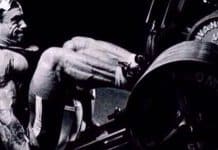Sumo Deadlift – Exercise Guide
The sumo deadlift is an exercise that catches a lot of unnecessary hate. Many people say that it is cheating, as it has far less of a range of motion than the conventional deadlift. But, the truth is, this deadlift variation is not necessarily cheating, but instead it is targeting different muscle groups.
Let’s break it down.
What is the Sumo Deadlift?
No, it has nothing to do with sumo wrestling, but instead the stance. The sumo deadlift gets its name from the sumo wrestler-inspired wide stance. Some lifters set their feet so wide, it almost causes concern that they will crush their toes when they lower the weight, and a stance that wide is why so many people consider sumo cheating, because that will greatly decrease the range of motion. However, it is allowed in competition!
Muscles Worked
Similar to the conventional deadlift, the sumo deadlift is also a compound exercise, which means it works multiple muscle groups all at the same time. The sumo deadlift variation targets the following muscle groups:
- Quads
- Glutes
- Inner thighs
- Hamstrings
- Core
- Lower back
The sumo deadlift is also a great movement to help work on and improve your mobility and flexibility.
Equipment needed
The best part is, you do not need a large amount of equipment to complete the sumo deadlift, all you need is a barbell and a few weights. However, as you get into heavier weights, a lifting belt could be good to help you brace your midsection. Also, if you like to pull for multiple reps, equipment such as wrist straps can be good to help you grip the bar. Keep in mind that when you use wrist straps, you are taking away from the work that your forearms do during this lift.
If you are lifting on a platform, sometimes the surfaces can get slippery, so looking into a good pair of weightlifting shoes or even deadlifting socks can be beneficial to your overall completion of the lift. Yes, there are socks designed specifically for deadlifting.
How to Perform the Sumo Deadlift
Now for the fun part of this article, the “how-to”. Let’s take a look at the steps to perform the sumo deadlift!
1. Approach a loaded bar lying on the floor. Take a very wide stance so that your feet are set near the collars of the barbell and are facing outwards in the 10 and 2 o’clock direction.
2. Bend at your hips to grab the bar with an alternating grip (unless you are using straps, then you can grip it double overhand). Your arms should be narrower than shoulder-width.
3. Take a deep breath, drop your hips and drive through your heels to lift the bar upwards. Extend through the hips and knees.
4. Drive your hips into the barbell, contract your shoulder blades and breathe out at the top of the movement.
5. Return to the starting position with a slow and controlled motion while breathing in.
6. Repeat for the recommended or desired number of reps.
Benefits of the Sumo Deadlift
So, what can the sumo deadlift do for you? Well, there are actually plenty of benefits that the sumo deadlift brings to the table. For starters, the Sumo deadlift may give an advantage to people that have exceptional hip mobility, a long torso, or short arms, as it allows the hips to start closer to the bar, with the torso in a more upright position. People with these features are often considered “deadlift specialists” because their body is built to put them at an advantage for movements like the sumo deadlift.
Another benefit of the Sumo deadlift is decreased pressure placed on the lumbar spine, actually significantly less activation than the conventional deadlift. The sumo deadlift puts more stress on the lower half, rather than the back, which is a big reason that you see sumo deadlifts programmed into leg days rather than back days, whereas the conventional deadlift is often programmed into one or the other, because it requires much more recruitment of the back muscles.
Other benefits of the Sumo deadlift include strength gains in the muscle groups such as the quadriceps, glutes, hamstrings, and other muscles of the posterior chain. In addition to building strength and helping to pack on muscle mass, the Sumo deadlift can actually be used as a rehabilitation exercise to overcome back injury. As stated above, the sumo deadlift does not recruit too much of the back, but rather more of the lower half. That being said, you are able to help strengthen your posterior chain through this movement without damaging the back even more. If this is your plan though, be mindful of the weight you use and your exercise form.
Sumo vs. Conventional
The eternal battle of which deadlift is better, sumo vs. conventional. Well, let’s take a look at the differences between these two lifts.
Starting with foot placement, during a sumo deadlift, your feet are placed wider than shoulder-width apart, and your toes should be pointed out slightly. This differs from a conventional deadlift, where your feet are placed shoulder-width apart, with your toes pointing forward.
The next biggest thing to discuss regarding these two lifts is range of motion. The sumo deadlift has a shorter range of motion than the conventional style. This is because the wider sumo stance allows you to get your body closer to the bar, which means you don’t have to lift it as high. It’s one of the reasons many people can lift more when they pull sumo, and no it is not necessarily “cheating”.
Another big difference between the two lifts are the muscles worked. The sumo deadlift primarily works the quads, glutes, and upper back (traps). The conventional deadlift primarily works the hamstrings, glutes, and the lower back.
Hand placement is another big difference between the two lifts, as the conventional deadlift grip is a little bit wider than your knees. When deadlifting with a sumo stance, the grip is much closer, as the hands are between your knees, less than 12 inches apart.
Is Sumo or Conventional Harder?
Well, there is no definitive answer to this question, as everyone is different. For many people, deadlifting in the sumo stance will allow them to pull more weight, but for some a conventional stance suits them better. When it comes to which one is easier, this largely will depend on the build of the individual, as well as their strength and flexibility capabilities. Typically, someone with a longer upper body is better suited for sumo.
Wrap Up
Overall, the sumo deadlift is an exercise that gets a lot of unnecessary hate. Although the range of motion is much shorter than a conventional deadlift, it still is a great exercise that brings a lot of benefits to the table.
Will you be deadlifting sumo?
For more news and updates, follow Generation Iron on Facebook, Twitter, and Instagram.
*Images courtesy of Envato














